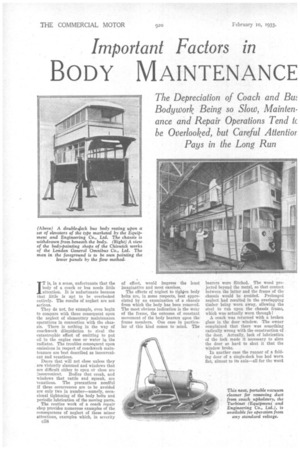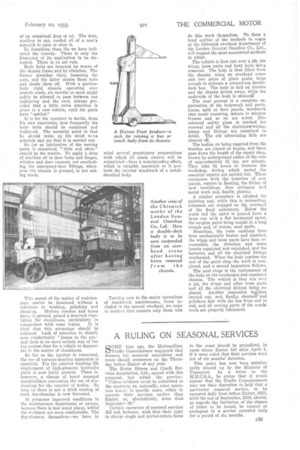Important Factors in
Page 108

Page 109

If you've noticed an error in this article please click here to report it so we can fix it.
BODY MAINTENANCE
IT is, in a sense, unfortunate that the body of a coach or bus needs little attention. It is unfortunate because that little is apt to be overlooked entirely. The results of neglect are not serious.
They do not, for example, even begin to compare with those consequent upon the neglect of elementary maintenance operations in connection with the chassis. There is nothing in the way of coachwork dilapidation to rival the catastrophic effect of omitting to put oil in the engine case or water in the radiator. The troubles consequent upon omissions in respect of coachwork maintenance are hest described as inconvenient and vexatious.
Doors that will not close unless they are violently slammed and windows that are difficult either to open or close are inconvenient. Bodies that creak, and windows that rattle and squeak, are vexatious. The precautions needful if these occurrences are to he avoided are only two in number—namely, occasional tightening of the body bolts and periodic lubrication of the moving parts.
The routine work of a coach repair shop provides numerous examples of the consequences of neglect of these minor attentions, examples which, in severity
bearers were hitched. The wood projected beyond the metal, so that contact between the latter and the frame of the chassis would be avoided. Prolonged neglect had resulted in the overlapping timber being worn away, allowing the steel to rub upon the chassis frame, which was actually worn through I
A coach was returned with a broken glass in the door window. The owner complained that there was something radically wrong with the construction of , the door. Actually, lack of lubrication of the lock made it necessary to slam the door so hard to shut it that the window broke.
In another case the runner of a folding door of a single-deck bus had worn flat, almost to its axis—all for the want of an occasional drop or oil. The door, needless to say, needed all of a man's strength to open or close it.
In describing these ills we have indicated the remedy. There is only the frequency of its application to be discussed. There is no set rule.
Body bolts are loosened by weave of the chassis frame and by vibration. The former stretches them, loosening the nuts, and the latter shakes these nuts and slacks them off. With a particularly rigid chassis operating over smooth roads, six months or more might safely be allowed to pass between one tightening and the next, always provided that a little extra attention is given to a new vehicle, until the parts have " settled."
It is for the operator to decide, from his own experience' how frequently the body bolts should be examined and tightened. The essential point is that he should make up Hs mind to sa schedule and see that it is carried out.
So far as lubrication of the moving parts is concerned, "little and often" should be the maxim. To apply a drop of machine oil to door locks and hinges, " window and door runners, not overlooking the emergency-door fittings, whenever the chassis is greased, is not asking much.
This aspect of the matter of maintenance cannot be dismissed without a reference to washing, polishing and cleaning. Modern coaches and buses have, in general, gained a deserved reputation for cleanliness, particularly in
comparison with some trains. It is vital that this advantage should be retained. Lack of attention to cleanliness emphatically "jumps to the eye,'. and there is no more certain way of losing custom than for a vehicle to degenerate in the matter of cleanliness.
So far as the interior is concerned, the use of vacuum-cleaning apparatus is essential. For the exterior washing tfln employment of high-pressure hydraulic plant is now fairly general. .There is, however, a change of heart amongst coachhuilders concerning the use of drycleaning for the exterior of bodies. So long as there is not a thick coating of mud, dry-cleaning is now favoured.
It promotes improved conditions in the maintenance department or garage, because there is less water about, whilst the workmen are more comfortable. The dry-cleaners themselves—we have in do this work themselves. To them a brief outline of the methods in vogue at the Chiswick overhaul department of the London General Omnibus Co., Ltd., will suggest the most economical methods to adopt.
The vehicle is first run over a pit, the wings, loose parts and body bolts being removed. The body is then lifted from the chassis, using an overhead crane and two pairs of giant grabs, large enough to embrace a covered-top doubledeck bus. The body is laid on trestles and the chassis driven away, while the underside of the body is eleanedi The next process is a complete examination of the bodywork and parts. Loose, split or bout panels, woodwork that needs renewing, defects in window frames and so on are noted. Discoloured safety glass is marked for renewal and all the electricals/wiring, lamps and fittings are examined in detail. The old advertising bills are cleaned off.
The bodies, on being removed from the trestles, are placed on bogies, and these pass down the length of the repair shop, drawn by underground cables at the rate of approximately ai ins, per minute. They take Si hours to traverse the workshop, during which period the essential repairs are carried out. These commence with the insertion of new panels, repairs to flooring, the fitting of new mouldings, then stringers and metal work and, finally, glazing.
A similar procedure is adopted for painting and while this is proceeding, trimmers are engaged on the overhaul of the fixed upholstery, Below the waist rail the paint is poured from a large can with a flat horizontal spout, the surplus paint being caught in a long trough and, of course, used again. Meantime, the loose cushions have been mechanically beaten and repaired, the wings and loose parts have been reenamelled, the direction and route boards repainted and varnished, and the batteries and all the electrical fittings overhauled. When the body reaches the end of the paint shop the work is completed, and a second inspection follows.
The next stage is the replacement of the body on the overhauled and repainted chassis. The vehicle is then run over a pit, the wings and other loose parts and all the electrical fittings being replaced. Another inspection is.Athen carried out, and, finally, cleaners . and polishers deal with the bus from end to end, and all moving parts of the coachwork are properly lubricated.




































































































































































